Module 11 Body language Unit 1 They touch noses 课件(共22张PPT)
文档属性
| 名称 | Module 11 Body language Unit 1 They touch noses 课件(共22张PPT) |
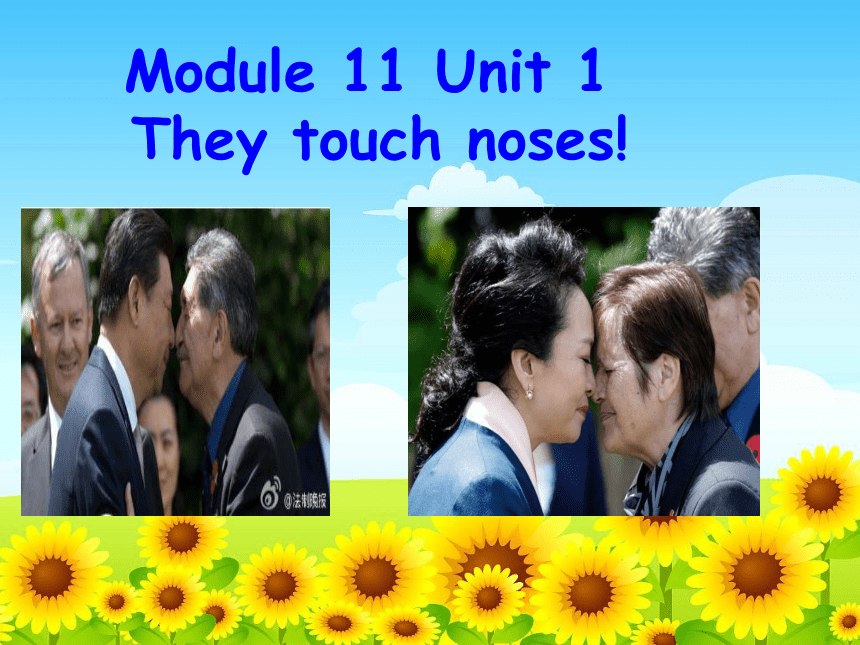
|
|
| 格式 | ppt | ||
| 文件大小 | 5.6MB | ||
| 资源类型 | 教案 | ||
| 版本资源 | 外研版 | ||
| 科目 | 英语 | ||
| 更新时间 | 2022-05-22 13:41:14 | ||
图片预览


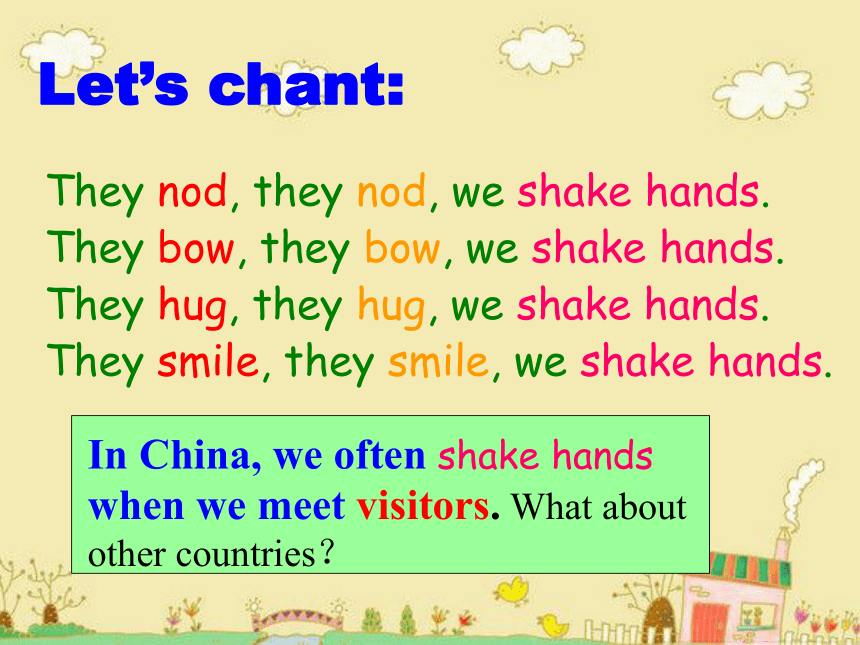
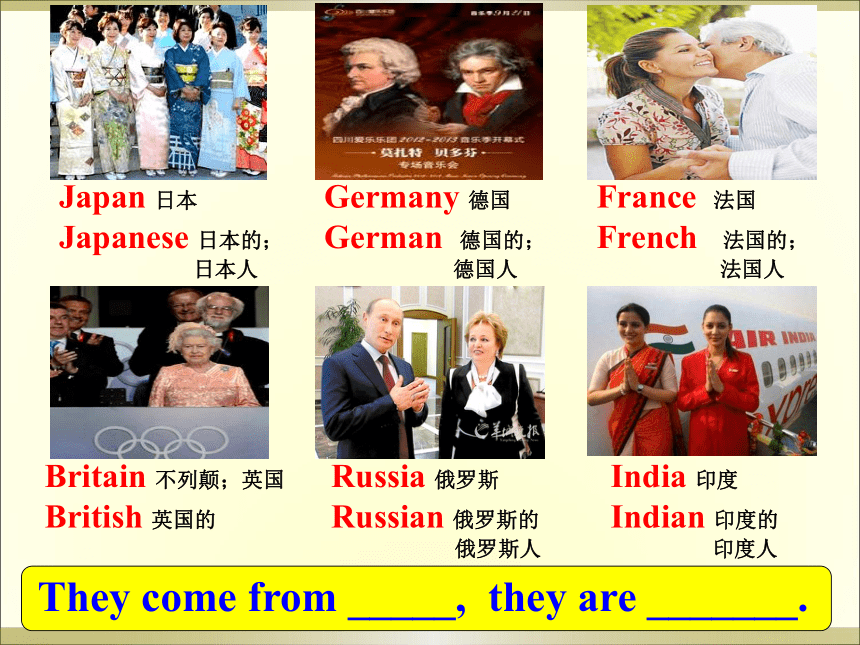
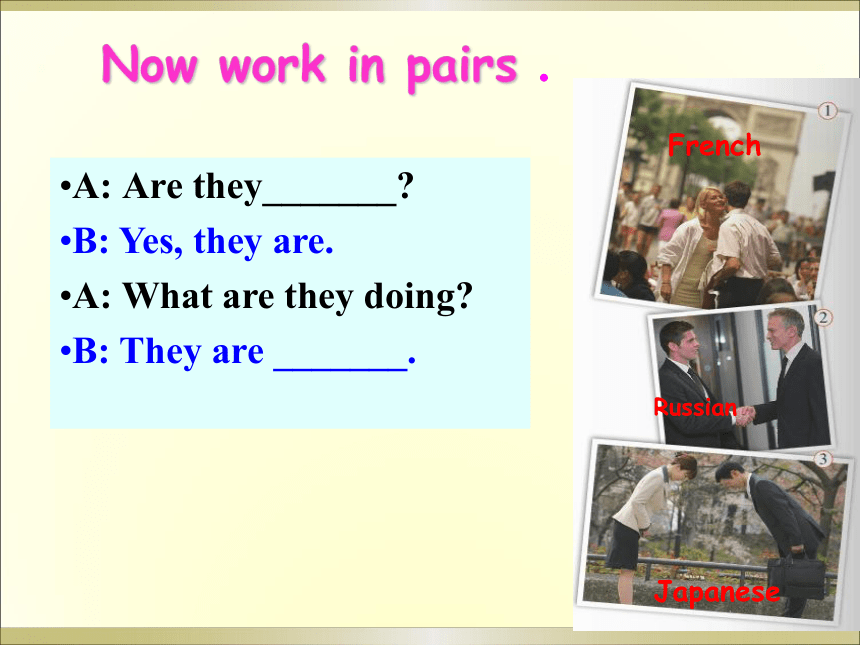
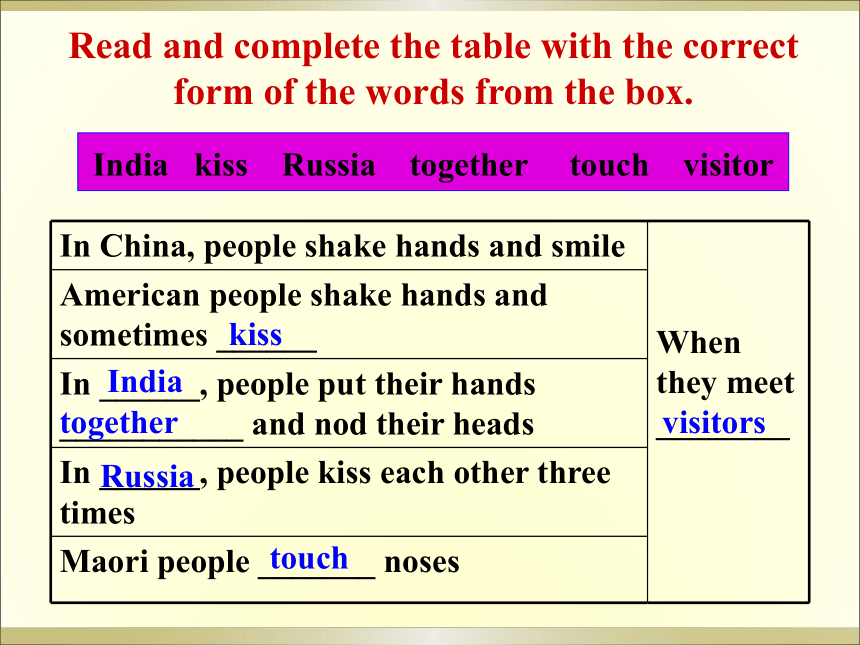
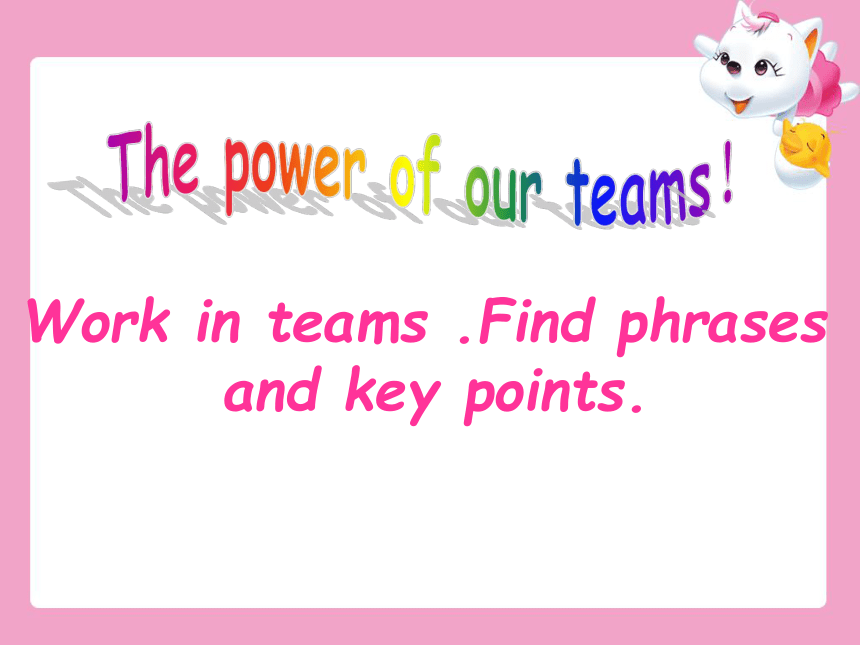
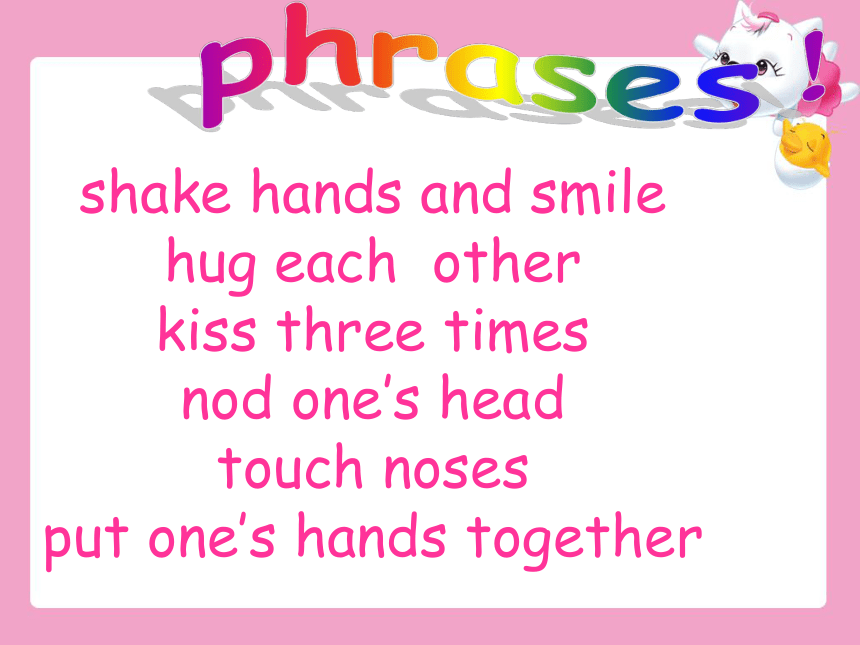
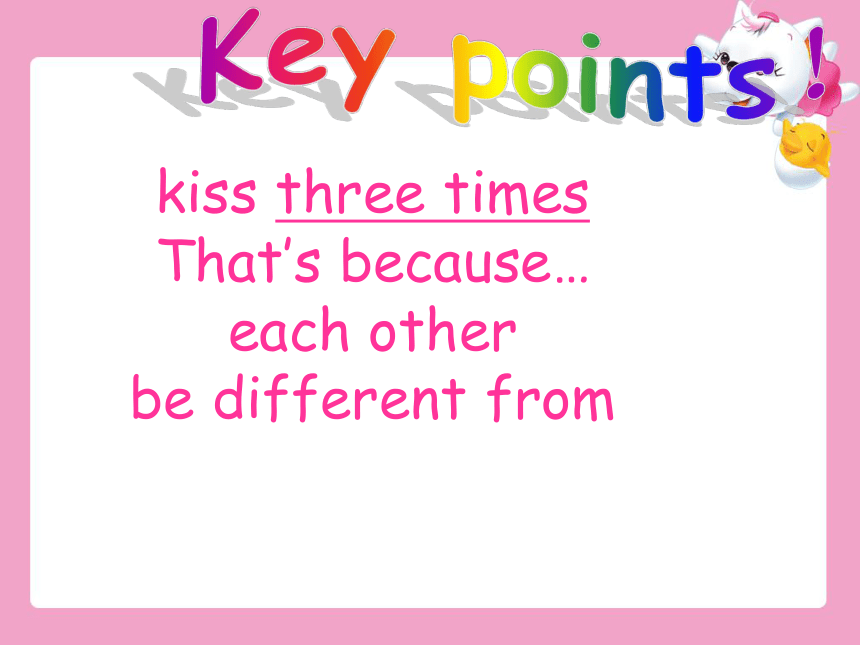
文档简介
(共22张PPT)
Module 11 Unit 1
They touch noses!
bow /ba /
kiss /k s/
shake hands / e k/
smile /sma l/
hug /h g/
nod /n d/
Read and do
They nod, they nod, we shake hands.
They bow, they bow, we shake hands.
They hug, they hug, we shake hands.
They smile, they smile, we shake hands.
Let’s chant:
In China, we often shake hands when we meet visitors. What about other countries?
Britain 不列颠;英国
British 英国的
Japan 日本
Japanese 日本的;
日本人
Russia 俄罗斯
Russian 俄罗斯的
俄罗斯人
India 印度
Indian 印度的
印度人
Germany 德国
German 德国的;
德国人
France 法国
French 法国的;
法国人
They come from _____, they are _______.
Now work in pairs .
A: Are they French
B: Yes, they are.
A: What are they doing
B: They are kissing.
A: Are they_______
B: Yes, they are.
A: What are they doing
B: They are _______.
French
Russian
Japanese
India kiss Russia together touch visitor
Read and complete the table with the correct form of the words from the box.
In China, people shake hands and smile
When they meet ________
American people shake hands and sometimes ______
In ______, people put their hands ___________ and nod their heads
In ______, people kiss each other three times
Maori people _______ noses
India
Russia
visitors
touch
together
kiss
Work in teams .Find phrases
and key points.
shake hands and smile
hug each other
kiss three times
nod one’s head
touch noses
put one’s hands together
kiss three times
That’s because…
each other
be different from
In Russia People usually _____ three times, left, right, left.
In China People often _____________ and ______.
In the US People shake hands, and some kiss or _____ each other.
In India People put their hands together and ____their heads.
In New Zealand Maori people _________.
People do different things in different countries.
A:
B:
C:
D:
E:
F:
In the US:
__________________
__________________
Shake hands,
kiss or hug each other
In India:
_________________
_________________
Body language
In China:
____________________
In Russia:
______________
Kiss three times
Shake hands and smile
Maori people:
_____________
Touch noses
Put hands together
and nod their heads
Some ______ visit the Great Wall every year.
A. visiter B. visitor C. visitors
2. Chinese often _____ when they meet.
A. shake hands B. shakes hands C. touch noses
3. They help ______ when they are in
trouble.
A. each B. each other C. the other
1. “Welcome!”, she s_____ hands and smiles.
2. She came and gave her grandpa a h__.
3. If you agree my ideas, you n__ your head.
4. Maori people in New Zealand t____ noses when they meet.
5. They b__ to their king every morning.
1. 我正在欢迎来访者。
I am _______________________ the visitors .
2. 我们中国人通常是握手和微笑。
We Chinese often _____________________ and smile .
3. 那是因为不同国家的人们做不同的事情。
_______________ people do different things in different countries .
4. 美国人常常是亲吻和拥抱对方。
American people often _________ or _____________ .
Some ______ visit the Great Wall every year.
A. visiter B. visitor C. visitors
2. Chinese often _____ when they meet.
A. shake hands B. shakes hands C. touch noses
3. They help ______ when they are in
trouble.
A. each B. each other C. the other
1. “Welcome!”, she s_____ hands and smiles.
2. She came and gave her grandpa a h__.
3. If you agree my ideas, you n__ your head.
4. Maori people in New Zealand t____ noses when they meet.
5. They b__ to their king every morning.
hakes
ug
od
ouch
ow
1. 我正在欢迎来访者。
I am _______________________ the visitors .
2. 我们中国人通常是握手和微笑。
We Chinese often _____________________ and smile .
3. 那是因为不同国家的人们做不同的事情。
_______________ people do different things in different countries .
4. 美国人常常是亲吻和拥抱对方。
American people often _________ or _____________ .
welcoming
shake hands
That’s because
kiss
hug each other
A: Meet your parents
B:Meet a famous star
C: Meet foreign visitors
People in different countries may use different body language. Try to understand them and respect them.
One world One dream
You and Me From one world We are family Travel dream A thousand miles Meeting in Beijing Come together Put your hand in mine
One world One dream
Module 11 Unit 1
They touch noses!
bow /ba /
kiss /k s/
shake hands / e k/
smile /sma l/
hug /h g/
nod /n d/
Read and do
They nod, they nod, we shake hands.
They bow, they bow, we shake hands.
They hug, they hug, we shake hands.
They smile, they smile, we shake hands.
Let’s chant:
In China, we often shake hands when we meet visitors. What about other countries?
Britain 不列颠;英国
British 英国的
Japan 日本
Japanese 日本的;
日本人
Russia 俄罗斯
Russian 俄罗斯的
俄罗斯人
India 印度
Indian 印度的
印度人
Germany 德国
German 德国的;
德国人
France 法国
French 法国的;
法国人
They come from _____, they are _______.
Now work in pairs .
A: Are they French
B: Yes, they are.
A: What are they doing
B: They are kissing.
A: Are they_______
B: Yes, they are.
A: What are they doing
B: They are _______.
French
Russian
Japanese
India kiss Russia together touch visitor
Read and complete the table with the correct form of the words from the box.
In China, people shake hands and smile
When they meet ________
American people shake hands and sometimes ______
In ______, people put their hands ___________ and nod their heads
In ______, people kiss each other three times
Maori people _______ noses
India
Russia
visitors
touch
together
kiss
Work in teams .Find phrases
and key points.
shake hands and smile
hug each other
kiss three times
nod one’s head
touch noses
put one’s hands together
kiss three times
That’s because…
each other
be different from
In Russia People usually _____ three times, left, right, left.
In China People often _____________ and ______.
In the US People shake hands, and some kiss or _____ each other.
In India People put their hands together and ____their heads.
In New Zealand Maori people _________.
People do different things in different countries.
A:
B:
C:
D:
E:
F:
In the US:
__________________
__________________
Shake hands,
kiss or hug each other
In India:
_________________
_________________
Body language
In China:
____________________
In Russia:
______________
Kiss three times
Shake hands and smile
Maori people:
_____________
Touch noses
Put hands together
and nod their heads
Some ______ visit the Great Wall every year.
A. visiter B. visitor C. visitors
2. Chinese often _____ when they meet.
A. shake hands B. shakes hands C. touch noses
3. They help ______ when they are in
trouble.
A. each B. each other C. the other
1. “Welcome!”, she s_____ hands and smiles.
2. She came and gave her grandpa a h__.
3. If you agree my ideas, you n__ your head.
4. Maori people in New Zealand t____ noses when they meet.
5. They b__ to their king every morning.
1. 我正在欢迎来访者。
I am _______________________ the visitors .
2. 我们中国人通常是握手和微笑。
We Chinese often _____________________ and smile .
3. 那是因为不同国家的人们做不同的事情。
_______________ people do different things in different countries .
4. 美国人常常是亲吻和拥抱对方。
American people often _________ or _____________ .
Some ______ visit the Great Wall every year.
A. visiter B. visitor C. visitors
2. Chinese often _____ when they meet.
A. shake hands B. shakes hands C. touch noses
3. They help ______ when they are in
trouble.
A. each B. each other C. the other
1. “Welcome!”, she s_____ hands and smiles.
2. She came and gave her grandpa a h__.
3. If you agree my ideas, you n__ your head.
4. Maori people in New Zealand t____ noses when they meet.
5. They b__ to their king every morning.
hakes
ug
od
ouch
ow
1. 我正在欢迎来访者。
I am _______________________ the visitors .
2. 我们中国人通常是握手和微笑。
We Chinese often _____________________ and smile .
3. 那是因为不同国家的人们做不同的事情。
_______________ people do different things in different countries .
4. 美国人常常是亲吻和拥抱对方。
American people often _________ or _____________ .
welcoming
shake hands
That’s because
kiss
hug each other
A: Meet your parents
B:Meet a famous star
C: Meet foreign visitors
People in different countries may use different body language. Try to understand them and respect them.
One world One dream
You and Me From one world We are family Travel dream A thousand miles Meeting in Beijing Come together Put your hand in mine
One world One dream
同课章节目录
- Module 1 Lost and found
- Unit 1 Whose bag is this?
- Unit 2 Are they yours?
- Unit 3 Language in use
- Module 2 What can you do ?
- Unit 1 I can play the piano
- Unit 2 I can run really fast
- Unit 3 Language in use
- Module 3 Making plans
- Unit 1 What are you going to do at the weekends?
- Unit 2 We're going to cheer the players.
- Unit 3 Language in use
- Module 4 Life in the future
- Unit 1 Everyone will study at home
- Unit 2 Every family will have a small plane.
- Unit 3 Language in use
- Module 5 Shopping
- Unit 1 What can I do for you?
- Unit 2 You can buy everything on the Internet
- Unit 3 Language in use
- Module 6 Around town
- Unit 1 Could you tell me how to get to the Nationa
- Unit 2 The London Eye is on your right.
- Unit 3 Language in use
- Revision module A
- Module 7 My past life
- Unit 1 I was born in a small village.
- Unit 2 I was born in Quincy.
- Unit 3 Language in use
- Module 8 Story time
- Unit 1 Once upon a time….
- Unit 2 Goldilocks hurried out of the house.
- Unit 3 Language in use
- Module 9 Life history
- Unit 1 He left school and began work at the age of
- Unit 2 He decided to be an actor.
- Unit 3 Language in use
- Module 10 A holiday journey
- Unit 1 What did you do?
- Unit 2 This morning we took a walk.
- Unit 3 Language in use
- Module 11 Body language
- Unit 1 They touch noses!
- Unit 2 Here are some ways to welcome them.
- Unit 3 Language in use
- Module 12 Western music
- Unit 1 It's so beautiful!
- Unit 2 Vienna is the centre of European classical
- Unit 3 Language in use
- Revision module B
